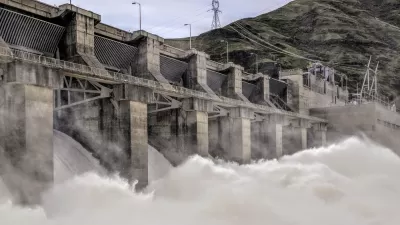As plans to build a major dam on the Amazon River edge closer to breaking ground, locals in nearby communities worry about the inevitable changes to come.
But along with concerns is the reality that the dam will bring much-needed hydropower to the region.
"Later this year a consortium of Brazilian construction and energy companies plans to start building a $4 billion hydroelectric dam on the Inambari River, which starts in the Andes and empties into the Madre de Dios River near Puerto Maldonado. When the dam is completed, in four to five years, its 2,000 megawatts of installed capacity-a touch below that of the Hoover Dam-will make it the largest hydroelectric facility in Peru and the fifth-largest in all of South America.
The Inambari dam, pending environmental impact studies, will be built under an agreement signed last summer in Manaus, Brazil, by Peruvian President Alan García and Brazil's then-president, Luiz Inácio Lula da Silva. In a joint statement released afterward, the pair praised the deal as "an instrument of great strategic interest to both countries." At first, most of the dam's electricity will go to Brazil, which desperately needs power to feed its economic expansion-a projected 7.6 percent in 2011, the fastest in nearly two decades. Over 30 years, the bulk of the electricity will gradually go to Peru to meet its own growing power demands. 'The reality is, every year we need more and more energy,' says Antonio Brack Egg, Peru's environmental minister. 'We need hydropower.'"
FULL STORY: A Mega-Dam Dilemma in the Amazon

Alabama: Trump Terminates Settlements for Black Communities Harmed By Raw Sewage
Trump deemed the landmark civil rights agreement “illegal DEI and environmental justice policy.”

Planetizen Federal Action Tracker
A weekly monitor of how Trump’s orders and actions are impacting planners and planning in America.

The 120 Year Old Tiny Home Villages That Sheltered San Francisco’s Earthquake Refugees
More than a century ago, San Francisco mobilized to house thousands of residents displaced by the 1906 earthquake. Could their strategy offer a model for the present?

USDOT Repeals Emissions Monitoring Rule
A Biden-era regulation required states to report and plan to reduce transportation-related emissions.

CaBi Breaks Ridership Record — Again
Washington D.C.’s bike share system is extremely popular with both residents and visitors.

San Francisco Opens Park on Former Great Highway
The Sunset Dunes park’s grand opening attracted both fans and detractors.
Urban Design for Planners 1: Software Tools
This six-course series explores essential urban design concepts using open source software and equips planners with the tools they need to participate fully in the urban design process.
Planning for Universal Design
Learn the tools for implementing Universal Design in planning regulations.
Clanton & Associates, Inc.
Jessamine County Fiscal Court
Institute for Housing and Urban Development Studies (IHS)
City of Grandview
Harvard GSD Executive Education
Toledo-Lucas County Plan Commissions
Salt Lake City
NYU Wagner Graduate School of Public Service





























